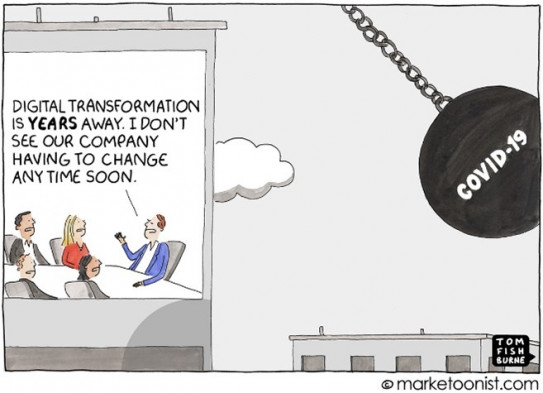
5 ways COVID-19 is impacting ecommerce
“What has been the impact of the global pandemic on ecommerce?” My usual reply would be that a crisis acts as a catalyst. It accelerates some of the anticipated ecommerce trends and places digital transformation at the top of most corporate agendas.

The big shock
The global pandemic has forced customers to change their habits. Physical shopping restrictions and lockdowns have changed typical buying behaviour and driven (even more) customers online. And since businesses inevitably follow their customers, the online range of products and services is getting more diverse every day. When COVID-19 was first declared a global pandemic by the WHO in March of 2020, most companies hesitated. Uncertainty caused them to freeze budgets and reduce spending. While at the same time, they acknowledged the need to invest in a (more performant) digital channel – which could make up for their loss in regular business. So as soon as companies recovered from the initial shock, they started acting. I have seen businesses adapt their strategy quickly. And in companies where digital transformation was not (yet) on the agenda, it became a top priority overnight. Here are the questions that I believe are being asked and what organisations are focussing on:
- Where are our customers? - A trend to go direct to consumers
- Where is our stock? - A renewed focus on supply and inventory management
- What is our purpose? - A review of corporate values
- Why would customers love our brands? - A shift towards empathetic and affinity marketing
- How quickly can we adapt? - A re-design of the solution architecture
-
Where are our customers?
The closing of physical shops does not only affect retailers. It also impacts the rest of the supply and production chain. Wholesalers and manufacturers experience a clear disruption in their supply and demand cycle. This uncertainty pushes companies to look for alternative markets or solutions to source and sell their products. One option for brands is to try and reach consumers directly. They extend (or abandon) their traditional partnership model and bypass (or eliminate) the need for wholesale or retail partners. This aspiration can take on many forms:
- enter marketplaces
- build (or extend) an own e-commerce platform (B2C or B2B2C)
- build (or extend) an own network of dedicated physical ‘brand stores’
That last option was clearly on the rise before COVID kicked in but has now obviously slowed down. However, the effort of building a shop network now seems to have shifted to setting up virtual brand stores on the major online marketplace platforms. These so-called ‘shop-in-shops’ are getting increasingly popular, such as for example the Beats or Lego stores on Amazon. This ‘Direct-to-Consumer’ trend started some years ago (look at Nike’s Consumer Direct Offense or a similar initiative from L’Oréal) but is now clearly accelerating. The pandemic seems to have lifted most of the reservations business had about this model. Instead, they now are now embracing it as a new distribution channel. And it gives them increased control of the overall brand experience. Yet, for this channel to be effective, companies must implement new pricing models and delivery processes. The shift from bulk pricing and transport to pricing and shipping individual packages, requires companies to rethink their business model. And they often need to supplement their own delivery fleet – which again leads to new partnerships with logistics and delivery service providers.
-
Where is our stock?
The COVID-19 crisis is challenging supply chain and inventory management in many ways. We all witnessed how supermarkets struggled to keep up with demands for food and other essential supplies (such as toilet paper ?). Other companies faced a surplus in raw materials due to a falling demand for their finished goods. And then there were the factories that had to close as part of lockdown measures. Each of these businesses needed to act rapidly to protect its operations and cope with disrupted supply chains. Companies realize they need (better) control over these complex inventory streams. To anticipate potential disruption and respond to changing demands, they need strong data and analytics capabilities. Increased inventory visibility is also crucial to improve customer satisfaction. More specifically in ecommerce it reduces the number of abandoned carts. Customers want to know stock levels, stocks locations and delivery times.
The pandemic has certainly succeeded in placing (improved) inventory management higher on the agenda. Companies will invest in providing accurate information on product availability to customers. Some organisations go as far as bringing (part of) the outsourced production process in-house (a strategy known as Vertical Integration). But that is clearly not a quick and short-term crisis response. It is rather a long-term change in strategy and vision. Apple for example decided to stop using processors from Intel and replace them with its own chips.
-
What is our purpose?
Before the pandemic, both companies and consumers alike, had taken for granted the fact that their basic needs and demands were being easily and instantly met. A wide variety of products and services was assumed to be always available. But then the ‘pause’ button was pressed ... The pandemic has given people the opportunity and time to consider the impact of their pre-Covid behaviour. Customers reflect more consciously on how, when and where they consume. And there is likely to be a significant shift towards products and brands that help customers to be more responsible towards themselves, others, society, and the environment. The significant impact that e-commerce operations have on the planet and society are conflicting with these growing expectations for sustainability and will continue to raise concerns.
Think about the seemingly endless parcel streams due to (all too) easy and free returns policies. Companies have started to blacklist ‘serial returners’ (though maybe not necessarily from an ecological conviction) and we’re likely to see more scrutiny in this field that has been wrongly overlooked by many eCommerce retailers. The Covid crisis has also created a sense of community - “we are all in this together” - which undoubtedly will raise people’s expectation of businesses being more socially responsible as well. There is a growing public awareness and protest against companies that are considered unethical, such as the increasing criticism of Amazon for example. It even led to calls for a Black Friday boycott of Amazon. Companies that recognize these challenges have started to reshape their organizations. They are shifting towards more genuine and authentic ‘Corporate Social Responsibility’ (or CSR) and also adopting this approach in their strategic marketing efforts, aiming to have more empathetic and real-time engagement with their customers.
-
Why would customers love our brands?
Affinity grows when customers see a particular brand as inherently superior because of the connection they have with it. But to get there, brands must be perceived as authentic and provide experiences that resonate with individual needs and expectations. Organisations can choose to be ‘a force for good’. But finding that delicate balance between profitability and a good and authentic customer experience, is not an easy feat. By helping business to become more resilient, and strengthening society, the goal is to embed purpose throughout an organization. But what does each individual customer find important? Even though deep insights into customer behaviours and affinities typically exist within a company’s sales or service team, that knowledge is difficult to exploit online. So, companies are modelling online customer profiles to support their personalization efforts. These profiles help them achieve the high degree of understanding they need. And marketers are also increasingly adopting digital tools and artificial intelligence (AI) to assist them in these efforts and produce actionable insights from large data sets.
Social media also happens to be a very effective way of helping to forge these profiles. At the same time, it is important not to mistake Facebook likes or Twitter followers for affinity. Affinity itself is a more meaningful connection than the mere click of a button. Organisations should complement typical performance-driven strategies with a brand awareness approach, as suggested by my colleagues from Wax. At the same time, social media companies know they are a gateway to customers. And they are now taking it one step further by blending ecommerce with their platforms. The recent launch of Facebook Shops (a partnership with Shopify) is following in the footsteps of China's wildly popular WeChat social commerce platform. Similarly, Facebook is rolling out more and more shopping features on Instagram. Brands can now create their own e-commerce stores on these platforms and drive traffic through targeted social media campaigns.
-
How quickly can we adapt?
Businesses want to ramp up their digital operations and they want to do it quickly. They need (more) agile and flexible software solutions that can adjust rapidly and help them serve new touchpoints overnight. That’s where API driven architecture and server-less microservices come in. They help teams work more independently, for example by decoupling backend and frontend applications. They allow organisations to deliver new features and prototypes faster and improves the integration within the existing landscape. And by leveraging cloud solutions, companies are ready for unplanned peaks in demand with more scalable and reliable systems.
If you want to learn more, I highly recommend this excellent whitepaper on Microservices, written by my colleagues from Osudio. A key example of how microservices can help organisations extend, customize, and scale their operations are payment services. COVID-19 has caused a rapid decline in cash usage as lockdown is keeping customers at home (+ there is a perceived infection risk from handling cash). As a result, all forms of electronic payment have quickly gained widespread adoption. And companies have realized they need payment processing anywhere and anytime. Yet, payments is too critical a service to tie in with your ecommerce platform data, code, and upgrade cycle. You should in fact want your payment provider to oversee timely patches and releases, always ensuring privacy and security.
As payments become more digitalized, they are also likely to become more ‘embedded’ into customer purchasing journeys, causing less friction and help automate repetitive buying. Contactless payments and digital wallets in particular are getting increasingly popular among smart phone users – which might in turn lead to a decline in card usage.
Conclusion Organizations are acting with a sense of urgency to moderate the damage the pandemic has done to their businesses, their customers, their people, and their partners. Their current focus is primarily short term, but many of the measures they are taking will most likely be the foundation for future sustainability and growth. Let’s hope we all come out stronger.